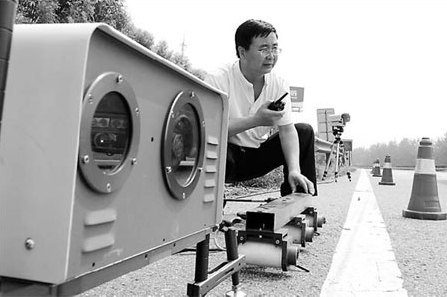An air quality monitoring and warning system to help guarantee clear skies for the Beijing Olympics in August has been fully implemented, scientists have said.

An environment official with a laser remote sensor tracks car emissions during the Olympic test events in August last year. Similar sensors will be used for the Games this August.
The 20-million-yuan ($2.9 million) project was jointly launched by the Beijing authorities and the Chinese Academy of Sciences (CAS), Liu Wenqing, the project's chief scientist and a professor of the Anhui Institute of Optics and Fine Mechanics under the CAS, told China Daily recently.
The project includes 11 air quality monitoring stations and three mobile surveillance vehicles that have been deployed in the capital.
Another 14 monitoring stations in a dozen cities surrounding Beijing will also provide data.
The information collected is expected to help authorities in the commitment to hold a green Olympics by targeting major polluters.
"Beijing's major pollutants - nitrogen oxides, sulfur dioxide, particulate matter, ozone and carbon monoxide - come from sources including vehicle exhaust, factories and volatile organic compounds in gas stations," Liu said.
The project is an extension of a trial held during the "Good Luck Beijing" test events for the Olympics.
Following the trial to monitor air quality, Beijing authorities launched a four-day experiment to see whether pulling 1.3 million cars off the capital's roads each day in an even-and-odd license plate rule that allowed them to drive into the city on alternate days would be effective in reducing air pollution during the Olympics.
During the experiment, the amount of pollutants in the city decreased by 17 to 28 percent, while the daily average pollutant levels met the national standard II, a standard accepted by the International Olympic Committee, Liu said.
The traffic control measures can help improve the city's air quality significantly, Liu said.
"Vehicle emissions contribute 60 to 70 percent of air pollution in Beijing and these pollutants can usually stay in the air for three to four days," Liu said.
"The oncoming two-month traffic control measure, scheduled to start from July 20, three weeks before the opening of the Games on Aug 8, is also expected to see good results," he said.
About 70 percent of the monitoring devices used in the latest project are domestically made hi-tech equipment that measure dozens of pollutants, including nitric oxide, carbon monoxide, methane, ammonia and volatile organic compounds, scientists said.
The rest are foreign-made equipment used to measure four types of pollutants - sulfur dioxide, nitrogen dioxide, ozone and the particulate matter PM 10.
The monitoring methods of the project are in accordance with world-advanced technologies and listed as verified technologies by the US Environmental Protection Agency, researchers said.
Ulrich Platt, a professor from the Institute for Environmental Physics under the University of Heidelberg in Germany, the initiator of one of the techniques used in the project, praised the air quality monitoring system.
"It is amazing that China achieved such progress in such a short period, almost in sync with developments in developed countries," Platt said in March when he visited the Anhui Institute of Optics and Fine Mechanics, which produced equipment used in the project.
Zhang Lijun, deputy director of the State Environmental Protection Administration, had earlier said he has full confidence in anti-pollution plans drawn up for the capital and five surrounding provinces.
"Our experts predicted that the standard of air quality can be guaranteed and the green commitment we made can be fulfilled," Zhang told a news conference in March.
As part of the green drive, the Beijing authorities have so far shut down polluting factories, enhanced supervision for construction, upgraded emission standards, reduced coal burning and controlled volatile organic compounds in gas stations. The city is also continuing to expand its public transportation system.
Still, experts have said that the weather and geographical conditions in Beijing and nearby areas play a decisive role in the accumulation and dispersion of regional air pollutants, particularly in summer.
Normally, winds from south and southeast sweep Beijing in summer, blowing the pollutants to the north and northwest, where mountains slow down the spread of the pollutants.
But if winds are strong enough, pollutants will disperse rapidly, experts have said. Rains also help clean the air of dust significantly.
(China Daily June 25, 2008)